Bikewatch: Montreal
Tagged: bike opinionEarlier this year my partner and I took a trip to Montreal, which is one of the premiere bikeable cities in Canada. While we were there, I made a point of trying to photograph bikes on the street that I found notable or interesting. I’ve documented some of my observations here - no scientific goal or structured data gathering. Just following my nose.
Be warned that a lot of these pictures are blurry, poorly lit, etc. I’m not a photographer by any means, and the cameras that I do own are pretty terrible.
The first thing that’s immediately noticeable with Montreal is that people use bikes to get around. Commonly. I know that people use them in my city as well, but you can really feel the scale of it in a city like Montreal. One telltale sign is the amount of derelict bikes, and bikes that have been locked up in haphazard places.
All too often at home (and in most major urban centers in North America, I feel) I struggle to find a place to lock up a bike. There simply are not bike racks around. Generally you just find a fence (or, if you’re feeling rude, a gas line) and lock to it, hoping it’s sturdy enough.
In Montreal, at least in downtown, they have little bike parking bollards every 20 to 30 meters on the sidewalk, and most of them are actively in use!
The Quintessential
These are bikes that I think embody Montreal in different ways. They’re examples of bikes I saw a lot of, and I just snapped a shot of one or two good examples.
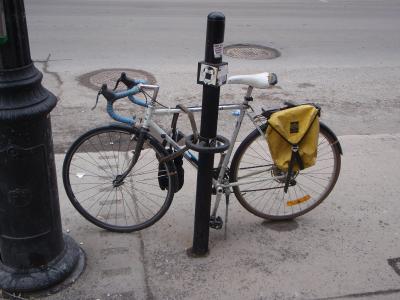
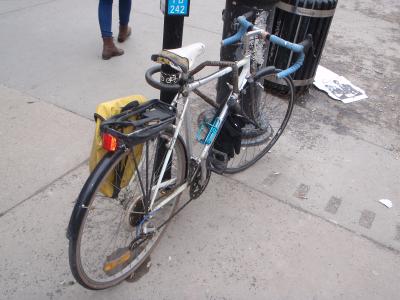
One neat thing is the prevalence of old steel bikes. This isn’t really a surprise - the Peugeot Bicycle Company opened a factory in Canada in the late 1970s. I actually fixed one of these up in my first blog post - The Peugeot Club UO5.
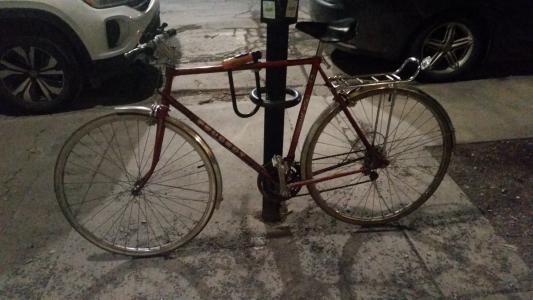
But it seems the classic Montreal bike is an old lugged steel frame, with 700C wheels and skinny tires. In my mountain town, our most common bikes are cheap hardtail mountain bikes with knobbly dirt tires. I think Montreal’s style is much more practical for city riding.
Another commonality that’s seen very often here and very seldomly in my home town is the use of a milk crate for carrying cargo. My partner told me the classic student bike has a milk crate bolted to the back - the cheapest and most effective way to carry groceries and backpacks. She was right - we saw plenty of old beater bikes with milk crates on the back. I took very few pictures of milk crated bikes, but trust me when I say there were lots of them.
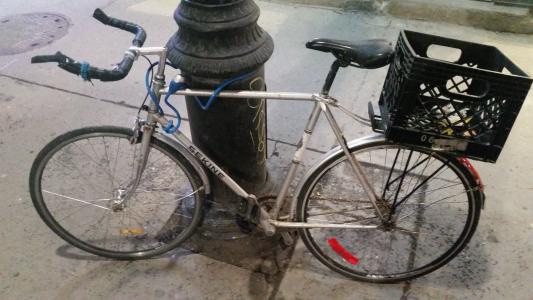
I say most of the bikes are 1980s steel bikes, but that doesn’t mean they’re all exactly the same. There are little personalizations and subtle differences in the bikes on display. Some are classic road bikes, yes, but I saw some step-through frames, and upright bikes as well. All with those elegant road bike wheels.
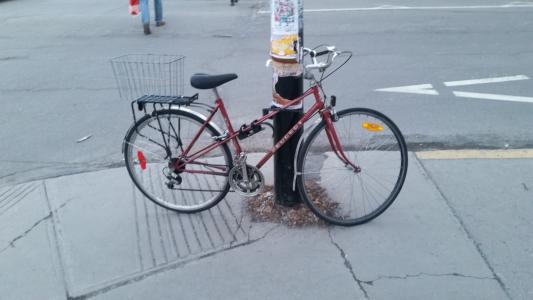
A few of them have also been retrofitted with new parts. There’s a great deal of mixing and matching going on even with all the old bikes. You can spy ancient machines with new saddles and pedals and cranksets and handlebars.
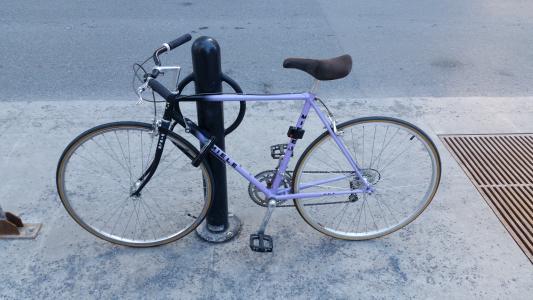
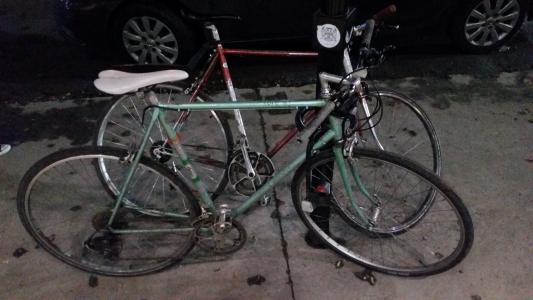
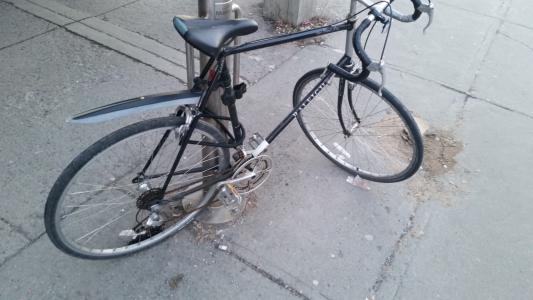
I was delighted when I found the familiar mountain bikes of my hometown as well. Below is a Gary Fisher steel frame rigid mountain bike, where somebody installed… fenders? For better city riding. Knobbly dirt tires + fenders is an odd look but I always appreciate when a bike is modified in small ways for better city riding.

And among all the vintage bikes and high-end bikes are, of course, the cheap bikes. Brand new department store bikes. By and large they are a little more tasteful than the ones I see at home. Fewer gaudy logos and gamer stripes on the paint job - they’re a little more minimal.
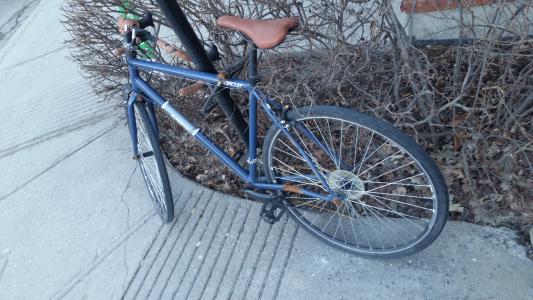
There are also the standard midrange bikes, like this one. It’s new enough that everything on it is stock, but not so new that there’s no sign of wear and tear.
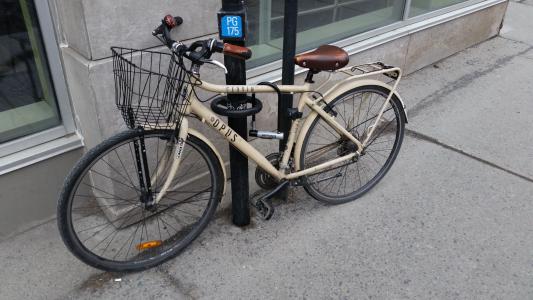
Fixed Gear & Single Speed
Last year I took a similar trip to New York, and kept a keen eye out for fixed gear cyclists and bike couriers. What I realized that they’re very much a dying breed - most couriers and food delivery drivers use e-bikes in New York, not fixies. I was surprised to realize that fixie culture is a LOT more alive in Montreal, at least judging from the bikes I saw being ridden and parked on the street.
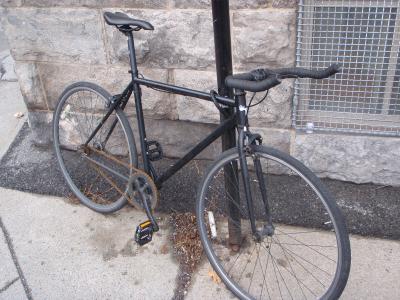
I think it’s interesting, because if you watch or read about “fixie culture” the place always mentioned is New York City. Montreal doesn’t really enter the equation. I have a hypothesis: Montreal fixed & single-speed riders do it because it’s cheap as hell and requires very little maintenance. ie. The original reason that these bicycles became associated with couriers living in New York.

There are exceptions to this of course. I did see some more expensive / custom bikes with a single speed or fixed sprocket on the back. This Surly frame was a surprise. This feels like someone’s into fixed gear riding as an identity trait.
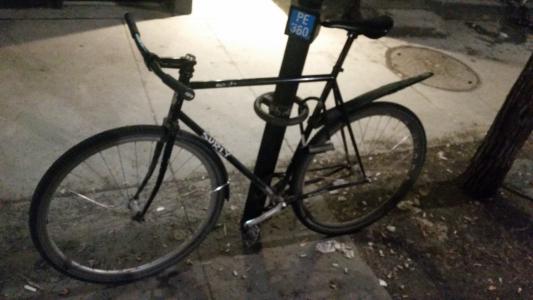
There’s also this newer midrange one I saw on McGill campus, with a comically overkill Kryptonite chain lock.
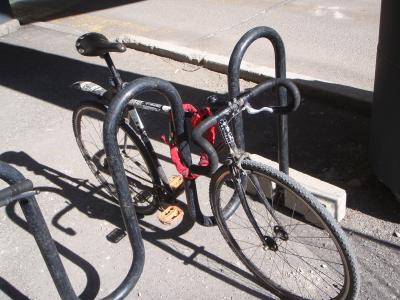
There were some other bikes that had personal flair and had clearly been replaced and repaired over the years like the Ship of Theseus. I love these bikes because they tell a story - not just about where they’ve been and what they’ve done, but about the rider and what they value. Below is one such bike.
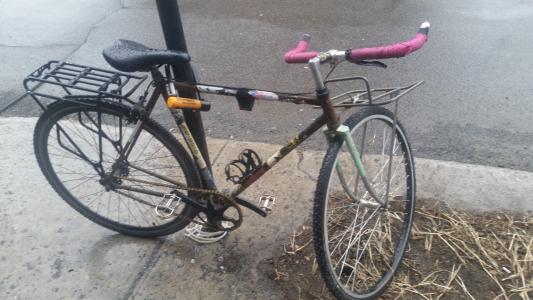
I honestly love this one so much. The frame looks like it’s been deliberately rusted, and for all I know , it has. The fork doesn’t match, but it gives a nice little accent. The wheelset is newer than everything else, but it’s certainly not high-end. It’s been sticker-bombed. There’s only one brake and it’s on the rear instead of the front, potentially because they installed a front rack. The front rack itself is almost certainly secondhand, bent up from some crash or mishandling. The saddle is new - can’t have one that soaks up water and releases it like a sponge when you sit on it, of course. The crankset is incongruously modern. The rear rack is an extremely high-end one, as is the rear brake. The horn handlebars with the pink grip tape. The tires are thick and knobbly for a road bike.
Everything on this bike speaks of daily use and abuse. It’s a workhorse for a very avid cyclist, and I love it.
Fancy Bikes
I also made a point of taking shots of bikes that were incongruously nice. These are bikes that would rarely get parked on the street downtown where I live. They’re not machines that are multiple thousands of dollars, they’re just solid, and well taken care of.
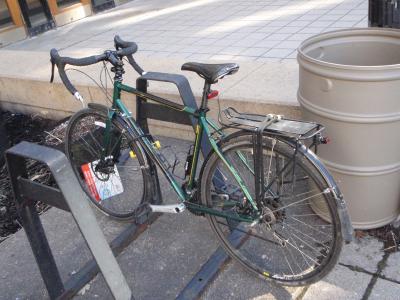
This one makes the list because it feels very personal to me, mostly because of the bar-end friction shifters. Drop bars, bar-end shifters, disc brakes, and a crank attachment type that’s newer than square taper tells me that the owner of this bike is Opinionated. I like the lights and the bungee cords too.

This one has all the bells and whistles. Thick tires, mudguards, a brooks saddle (by itself easily $200), fancy alt bars, a rear wheel lock (what), a front and rear touring setup, a REAR VIEW MIRROR, and even a tow hitch on the rear chainstay. I know it’s got a very fancy internally geared hub in the back, but part of me wonders if this hasn’t also been converted to an e-bike. It’s gotta be quite heavy. Is that mount in the middle of the frame for a battery? I’m honestly still not sure. It would explain the extra cable coming off the right grip.
Either way, this bike is a LOT and I’d be anxious leaving it locked outside in my city. I also like that despite having literally every modern feature, he still opted for a steel frame instead of aluminum or carbon. I’m starting to feel like this is how cycling culture is in Montreal.
Also, shoutouts to the Univega Alpina in the background. I fixed one of those for a coworker not too long ago.
The Derelict
In addition to all the wonderful bikes that were clearly being actively ridden, there were a lot of bikes which were decidedly…not. These were either abandoned or destroyed, or else so caked in rust it was hard to imagine them going anywhere. The downside of having a lot of people getting around by bike is that bicycles are cheap, unregistered, and utterly abandonable. Eventually people will simply walk away from them and they’ll become litter on the streets. It’s a sad reality.
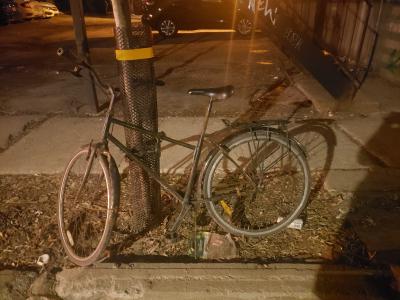
I like a lot of these because they’re generally very low-end, and sometimes you have to wonder if they’re actually abandoned, or if they’re still being ridden around, squealing and clunking along, until they eventually break down.
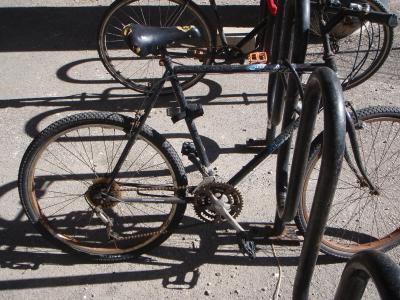
Some bikes aren’t rusty or missing pieces, but it’s clear that they aren’t being ridden from other telltale signs. This one’s chain is off its sprockets, and it’s basically calcified. Plus, the bar tape is coming off.
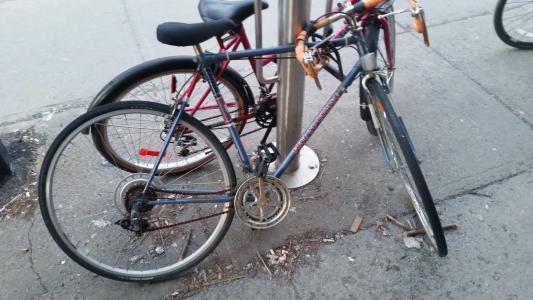
And others are so far gone you wonder why the city hasn’t just taken a saw to the frame and sent them to the scrap pile. I’m sure it happens regularly.

Bikes (Or lack thereof) in Old Quebec City
Halfway through our journey, we took a trip by train into Quebec City, and stayed in a hostel in Old Quebec City.
The streets were narrow and rough and cobbled, and many avenues were closed due to snow pileup. I kept my eyes open for bikes here, too, and found almost none.

With its rough roads, steep inclines, and absurd density, it’s no surprise that Quebec City isn’t home to many bikes. I only found a couple of nondescript ones - aluminum framed city bikes with slightly newer components. A far cry from the ubiquitous steel workhorses of Montreal.
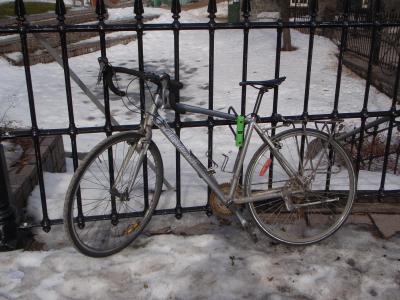
Though it was still pretty much winter when we went. It’s fully possible that there are a lot of fairweather cyclists ready to carry their bikes down the stairs at the first signs of spring.
The Unusual
A final shoutout goes to the unusual bikes, the ones that defy classification. These ones are custom built or special ordered, and it’s quite rare to find them just locked up on the street. But they are around. I didn’t get any pictures of bakfiets (those front-bucket bikes for carrying cargo or kids) because I didn’t see any locked up on the street, but I did see a few people actively riding them.
I did see some long-tail cargo bikes, such as this one:

I was hoping we’d run into its owner, but we never did. To me, the most remarkable thing about this bike is that it isn’t an e-bike. It’s also got some totally DIY’d rear wheel guards and seat pads. Someone with VERY strong legs probably takes their kid around town on this thing. Very cool!
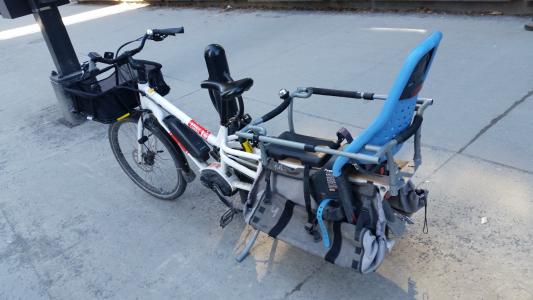
This is a fancier version of the previous one. It’s a fully kitted e-bike with a proper child seat in the back, and plenty of room for cargo. The rider isn’t insane, though, so it’s got an electric motor to help with those montreal hills. I love seeing this kind of stuff - the more people getting around a city like this, the better.
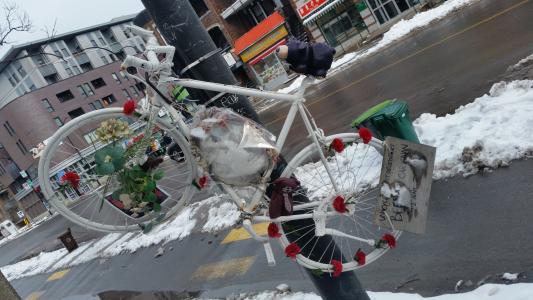
This one is less encouraging. This is a ghost bike, which is a memorial for a cyclist killed in traffic. This was likely set up by Souliers et vélos fantômes which is a Montreal organization that creates these memorials, for both cyclists and pedestrians (who are memorialized with pairs of white shoes). These may feel a little bleak, but I think it’s a good thing to make these so visible. Especially if there are flowers around, and people paying their respects to the departed. It makes the toll that car infrastructure takes on us visible and tangible. It’s a political statement that will hopefully lead to reform.
And to end on a happy note, here’s a cool little modified bike I saw one night. It’s a nice and practical city hybrid bike, but with a cute cargo-carrying twist on the front fork:
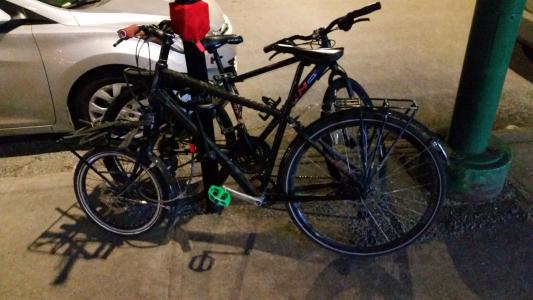
Trying the Bixi Service
Montreal has a bikeshare program! A fairly well established one too, with bespoke stations taking up public space, usually near metro stations. (Sidenote: The Metro is impressively good. It’s nicer than New York, even. Probably one of the best metro systems in North America as a whole.)
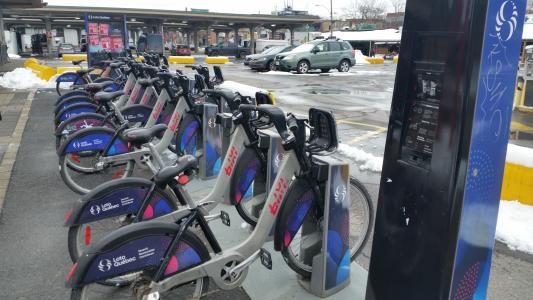
My overall experience wasn’t too stellar, and I’m not totally sure I’d recommend it. But there were some definite upsides and overall it looks promising.
Bixi has a phone app that lets you scan a QR code to unlock and check out a bike. I didn’t want to use this. I’m a bit averse to downloading apps on principle, but I don’t live in Montreal, so I’d rather not sign up for a service that I’m only going to use once. I had done some pre-reading, and it seemed like it would be possible to just pay by card at one of the bixi terminals. This turned out to be true - except that the first bixi station I encountered didn’t have such a terminal. It was phone-only. I ended up needing to walk to the next station over.
Fumbling with a phone to scan a QR code in winter is a bit of a pain, especially when your phone is as outdated as mine is, but I imagine this is the generally preferred method of using the service for Montreal residents.
The bikes are a bit heavy and unwieldy, but they’re very rugged and look like they’re built to be foolproof in terms of maintenance. They also had riveted winter tires, which was a very pleasant and welcome surprise.
The biking infrastructure around Montreal was pretty fantastic - it wasn’t a flawless experience, of course, I was biking in the heart of downtown with no real familiarity with the geography or the mannerisms of the city, and I did run into surprise construction, but it was still navigable and felt safe. That’s a pretty powerful testament to the quality of the infrastructure in place.
The cost was less than impressive - it ended up being more expensive than taking transit for the distance that I went. Montreal’s transit infrastructure is very impressive, though, so that’s understandably a difficult hurdle to overcome. There was a one-time fee of $1.55 for using the bicycle, and then a $4.14 fee for the time that I took traveling. There is also a $100 hold they place for funds on your credit card, for security in case the bixi is not returned. This hold was released a few days later without issue. For reference, a one-way transit fare in Montreal is $3.75, which can be further discounted if purchased in bulk.
The time it took was probably comparable to transit, however, or perhaps even a little faster. My partner and I left our hostel at the same time, and despite my issues with the first station and needing to walk to a different bixi station (after trying and failing to download the app and make an account), and meandering through construction detours on unfamiliar streets, I arrived at our destination less than five minutes after my partner. Another win for public transit, sure, but I think a habitual bixi rider would be much more efficient than me, and therefore pay less and take less time.
As it stands, I’m not sure that using the bixi service is economical or practical compared to taking transit, but I haven’t run the numbers in detail. All I know is that the bike felt safe and comfortable (if a little heavy) and the service was easy to use (barring the issue with needing a smartphone to use every station).
That’s all for now. I had a wonderful time in Montreal, and it was refreshing to see such a thriving bicycle culture, even in the later stages of winter.